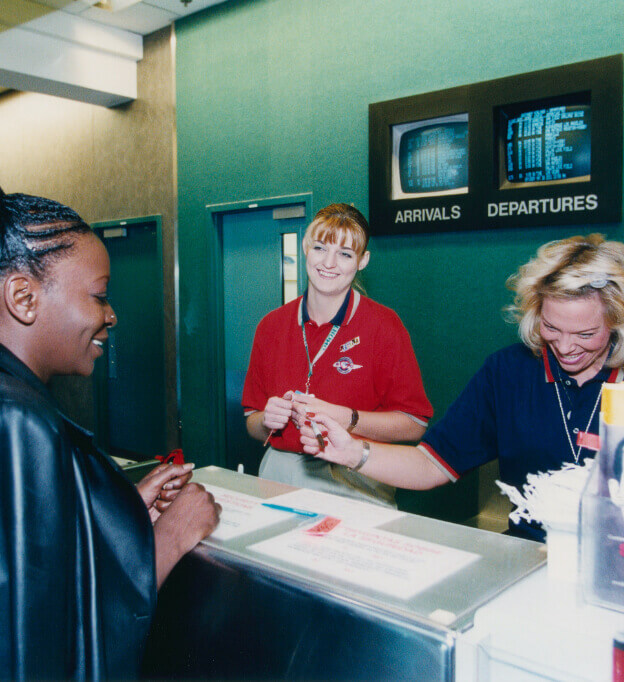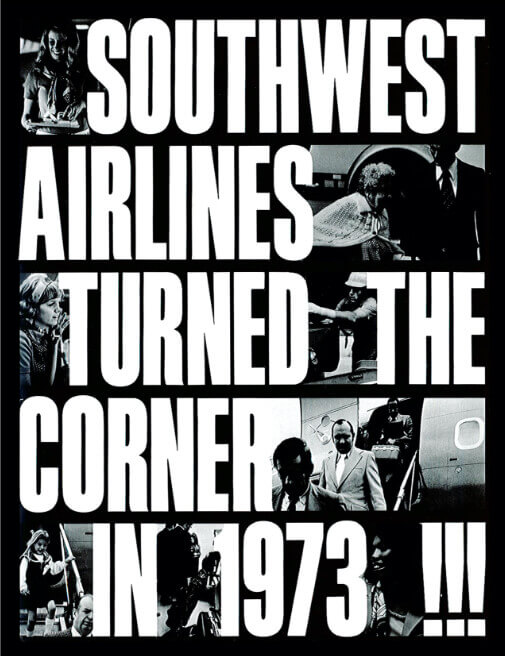
Southwest’s Customer-centric Culture is built on its Employee ownership model.
Paying It Forward: The Southwest ProfitSharing Plan
Christmas of 1971 was just around the corner—and so were Joy’s money troubles. Joy, a part-time model, had taken a temporary gig managing a Christmas tree lot in Hurst, Texas, to make ends meet. But Christmas trees weren’t a year-round business. When the holidays ended, so did the income she needed to stay afloat.
On a whim, the 23-year-old took a trip to Love Field to see if she could land some work with one of the airlines operating at the airport and stumbled upon Southwest.
“I asked, ‘What’s Southwest?’ I’d never heard of it before,” Joy said.
The chance encounter with the brand-new airline would change Joy’s life. She was immediately offered a hybrid position as a secretary and ticket agent. Twenty-five years later, as the office manager of Love Field operations, Joy was looking forward to retirement as a millionaire—thanks in large part to the Southwest ProfitSharing Plan.
The 195 Employees who joined Southwest in its first year of operation had signed on to an uncertain business proposition that would require healthy doses of grit and tenacity to be profitable. But those who stuck it out would reap the rewards: When Southwest turned its first profit in 1973, the first thing the Company did was set up a profitsharing program to reward its Employees.
At the time, no other airline in the country was giving its employees this kind of tangible ownership in their company’s success. “Historically, it’s the only profitsharing plan that was implemented by a company simply because the Board thought it was the right thing to do,” said former Executive Vice President and Chief Operations Officer Gary Barron. Today, the Southwest ProfitSharing Plan is no longer the only profitsharing plan in the business.
Southwest’s original plan was rooted in the purchase of Southwest stock—25 percent of any individual’s profit share was earmarked for stock purchase. Today, most Employees receive the first 10 percent of their profitsharing amount as a retirement contribution and then receive the rest in cash. In addition to the Company’s traditional profitsharing plan, Employees also have the option of purchasing Southwest stock at a discount. As a result, as of May 2020, Employees owned 6.9 percent of the Company, and that sense of ownership pays big dividends in terms of Company Culture.

Southwest’s 1973 Annual Report announces the Company’s first year of profitability since its planes took flight in 1971.
When an Employee’s well-being is tied to the Company’s well-being, they become keenly aware of how their daily activities affect the Company’s profitability, said Executive Vice President and Chief Financial Officer Tammy Romo. So it’s no surprise to see Employees going out of their way to be as resourceful as possible with the Company’s assets.
Pilots work with Dispatchers to figure out how to maximize speed and minimize fuel consumption on flights. They learn which runways can be safely taxied to on a single engine so they waste less fuel on the ground. Employees step up to take care of tasks beyond those in their official job descriptions because they recognize that everything they do contributes to the Company’s bottom line.
When an Employee discovered that a baggage sizer at the gate was broken and that it would be expensive to replace, he reached out to a Colleague on the Ground Support Equipment (GSE) Team to see if it could be welded back together. GSE normally handles repair requests only outside on the ramp, but they immediately sent a tech to pick up the broken baggage sizer and had it repaired within the day—saving the Company hundreds of dollars.
In San Antonio, a particularly difficult Customer was giving a Customer Service Agent a hard time and said, “Don’t you know I’m a Shareholder of Southwest Airlines?” The Agent looked at her and said, “We all are.”
“Employees feel like owners because they are owners,” said President Emeritus Colleen Barrett. “Ownership is one of the things our Employees are most proud of. How can you expect People to have passion and excitement for what they do if they’re not owners?”
The Southwest Culture of ownership and empowerment—fed by the Employee-first mentality Southwest was founded on—has been a driving force behind its remarkable profitability. Founder Herb Kelleher recalled many business schools asking him how he chose which constituency to serve first: Employees, Customers, or Shareholders. “It’s not a conundrum,” he told them. “Your People come first. And if you treat them right, they’ll treat the Customers right, and the Customers will come back, and that’ll make the Shareholders happy.”
If the Company’s 96 percent Employee retention rate and Customer satisfaction are any indication, the unconventional approach to putting Employees first is truly paying it forward.
